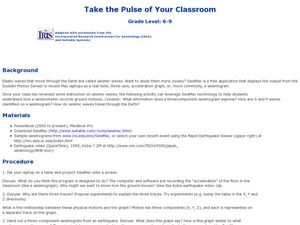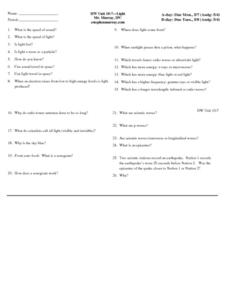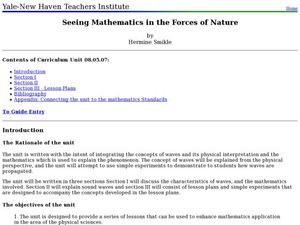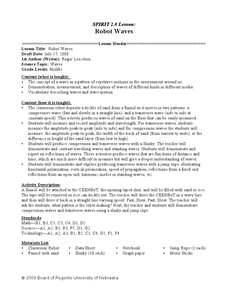Exploratorium
Cylindrical Mirror
Using flexible mirror-like paper, physical scientists experiment with images produced by curving it and looking into its reflective surface. They find that concave mirrors cause reflected light waves to cross and actually flip the image...
College Board
2018 AP® Physics 1: Algebra-Based Free-Response Questions
Whether determining orbitals of space craft or designing experiments with conductive dough, many young scientists discover physics is phun and attempt the AP exam to get college credit. Use the free response questions from the 2018...
Curated OER
The Energy of Waves
In this science worksheet, middle schoolers examine the topic in order to solidify knowledge covered in the curriculum using puzzles and creative games.
Curated OER
Reflection and Refraction
What is a prism? A place for light waves that commit minor refractions! The thorough resource includes three hands-on investigations covering light reflection and refraction; mirrors, lenses, and images; and optical systems. Subject...
Curated OER
Oceanography Worksheet #1
If you are teaching physical oceanography to middle school earth scientists, here is a terrific multiple choice worksheet. Learners look at a diagram of a landscape created by glacial sediment deposition and the resulting ocean floor....
E Reading Worksheets
Making Predictions #1
How can you tell what is going to happen next in a story? Learn to make predictions with five sections of stories. Kids read the beginning, and then write what they believe will happen next. Additionally, they provide evidence for their...
NASA
The Atmospheric Filter
What is the difference between a comet and a meteoroid? An educational lesson includes five demonstrations of how the atmosphere can inhibit our ability to measure many things in the galaxy.
PBS
Paper Table
What is black and white and re(a)d all over? Class members build a table out of rolled newspapers. Pupils follow the design process to design, build, and test their paper tables in the second challenge in a series of five.
Curated OER
Electromagnetic Energy and Its Spectrum
Your older elementary students investigate electromagnetic energy and the electromagnetic spectrum. They will observe 7 items represented in the electromagnetic spectrum and make a poster of all the things the items have in common. After...
Curated OER
The 1:1 Transition: What to Read Before You Implement
Capitalize on the wisdom, experience, and recommendations of those who have blazed the 1:1 trail.
Curated OER
The Visible Spectroscopy Expert Witness Problem
In a simulated crime science investigation, chemistry or physics sleuths use spectroscopy to analyze solutions. The lesson gives learners practice making salicylate solutions, using spectrophotometers, calculating dilution amounts,...
Curated OER
How We Hear
Learners study how sounds are transmitted from the environment to the brain. In this investigative lesson students participate in activities that show them how we hear, what sound waves are and the difference in seeing and feeling...
Mr. E. Science
Sound
Since light travels faster than sound, some people may appear bright until you hear them speak. The presentation covers what sound is, how fast it travels in various mediums, properties of sound, hearing, and the parts of the human...
Curated OER
Earthquakes Study Guide
In this earthquakes worksheet, students answer questions about the components of earthquakes, the causes of earthquakes, how they are measured, the types of seismic waves and the types of faults. They also answer questions about the...
Curated OER
Using Bubbles to Learn about Light Interference
Students explore constructive interference and destructive interference. In this light travel lesson, students follow procedures to discover how light waves travel and experience interference.
Curated OER
Take the Pulse of Your Classroom
Students discuss seismic waves. In this science lesson, students investigate the acceleration of the floor in the classroom similar to a seismograph. Students observe a three-component seismogram from an earthquake and determine what it...
Curated OER
HW Unit 10:7-Light
In this light worksheet, students answer twenty six questions about sound and light and how they both travel. They also answer questions about different types of waves in the electromagnetic spectrum such as radio waves, visible light,...
Curated OER
Stargazers
Students discuss the light spectrum and light waves as well as how the properties of light and color have contributed to important discoveries about properties of the universe. They research the term redshift and the redshift phenomenon...
Curated OER
Seeing Mathematics in the Forces of Nature
Students study waves and their characteristics. In this wave instructional activity students calculate the speed of waves, wavelength and the period.
Curated OER
The Heat Is On!
Students research severe weather conditions common to their geographic location and create weather emergency guides. They, in groups, develop guides for extreme weather conditions such as heat waves, tornadoes, floods, and storms.
Curated OER
Waves : An Alternative Energy Source
Students evaluate the feasibility of wave energy as an alternative source of energy. In this alternative energy source lesson plan students are introduced to renewable and nonrenewable energy and study energy production.
Curated OER
Robot Waves
Students differentiate the properties of longitudinal and transverse waves. In this physics lesson, students calculate CEENBoT's rate of propagation by measuring its frequency and distance per cycle. They use a mathematical formula...
Curated OER
Message in the Waves :Two Earth Day Lessons for Middle School Students
Fifth graders are introduced to Earth day and study the nesting colonies of Midway. In this Earth Day lesson students watch an online clip and see the effects our waste has on wildlife.
Curated OER
Innovation: Light Speed
Get your scholars working at "light speed" with this worksheet on how different wave frequencies have been discovered and used. The assignment has 20 short-answer questions, set up in a table. Consider re-doing the table or allowing...























